7.1 Water Cycle and Fresh Water Supply
Section Goals:
- Understand the abundance of different types of water.
- Describe the different fresh water reservoirs.
- Understand watersheds and the water table.
Water is Essential
Water, air, and food are the most important natural resources to people. Humans can live only a few minutes without oxygen, less than a week without water, and about a month without food. Water also is essential for our oxygen and food supply. Plants breakdown water and use it to create oxygen during the process of photosynthesis.
Water is the most essential compound for all living things. Human babies are approximately 75% water and adults are 60% water. Our brain is about 85% water, blood and kidneys are 83% water, muscles are 76% water, and even bones are 22% water. We constantly lose water by perspiration; in temperate climates we should drink about 2 quarts of water per day and people in hot desert climates should drink up to 10 quarts of water per day. Loss of 15% of body-water usually causes death.
Earth is truly the Water Planet. The abundance of liquid water on Earth’s surface distinguishes us from other bodies in the solar system. About 70% of Earth’s surface is covered by oceans and approximately half of Earth’s surface is obscured by clouds (also made of water) at any time. There is a very large volume of water on our planet, about 1.4 billion cubic kilometers (km3) (330 million cubic miles) or about 53 billion gallons per person on Earth. All of Earth’s water could cover the United States to a depth of 145 km (90 mi). From a human perspective, the problem is that over 97% of it is seawater, which is too salty to drink or use for irrigation. The most commonly used water sources are rivers and lakes, which contain less than 0.01% of the world’s water!
One of the most important environmental goals is to provide clean water to all people. Fortunately, water is a renewable resource and is difficult to destroy. Evaporation and precipitation combine to replenish our fresh water supply constantly; however, water availability is complicated by its uneven distribution over the Earth. Arid climate and densely populated areas have combined in many parts of the world to create water shortages, which are projected to worsen in the coming years due to population growth and climate change. Human activities such as water overuse and water pollution have compounded significantly the water crisis that exists today. Hundreds of millions of people lack access to safe drinking water, and billions of people lack access to improved sanitation as simple as a pit latrine. As a result, nearly two million people die every year from diarrheal diseases and 90% of those deaths occur among children under the age of 5. Most of these are easily prevented deaths.
Water Reservoirs and Water Cycle
Water is the only common substance that occurs naturally on earth in three forms: solid, liquid and gas. It is distributed in various locations, called water reservoirs. The oceans are by far the largest of the reservoirs ,with about 97% of all water, but that water is too saline for most human uses (Figure 1). Ice caps and glaciers are the largest reservoirs of fresh water but this water is inconveniently located, mostly in Antarctica and Greenland. Shallow groundwater is the largest reservoir of usable fresh water. Although rivers and lakes are the most heavily used water resources, they represent only a tiny amount of the world’s water. If all of world’s water was shrunk to the size of 1 gallon, then the total amount of fresh water would be about 1/3 cup, and the amount of readily usable fresh water would be 2 tablespoons.
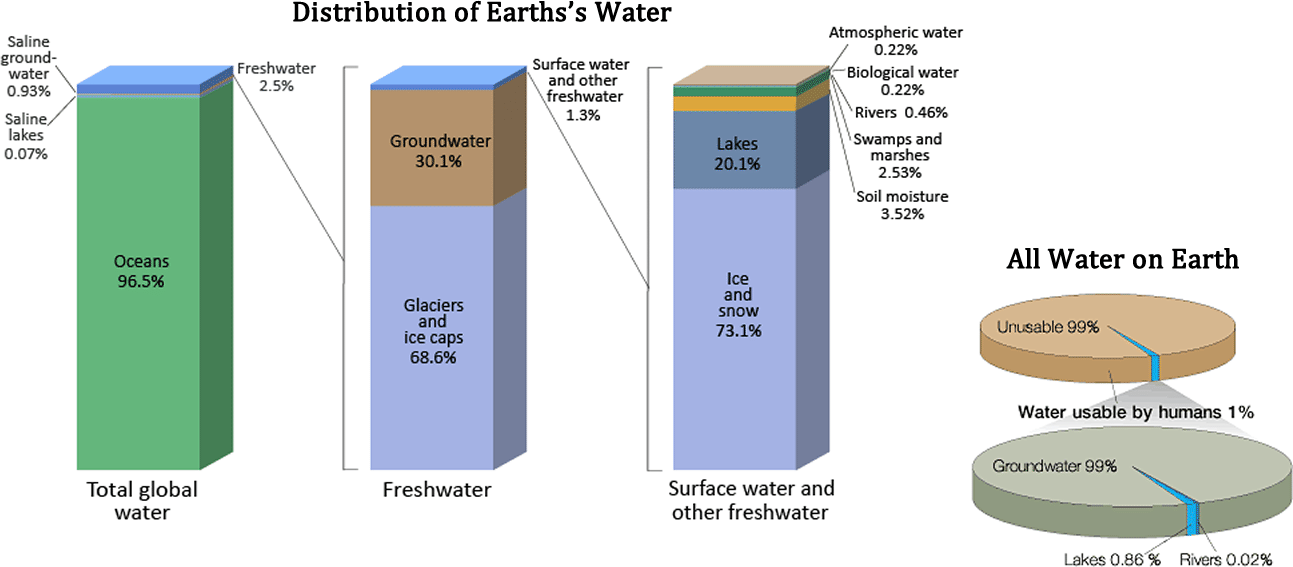
The water (or hydrologic) cycle (that was covered in Section 3.4) shows the movement of water through different reservoirs, which include oceans, atmosphere, glaciers, groundwater, lakes, rivers, and biosphere (Figure 2). Remember that solar energy and gravity drive the motion of water in the water cycle.

An important part of the water cycle is how water varies in salinity, which is the abundance of dissolved ions in water. The saltwater in the oceans is highly saline, with about 35,000 mg of dissolved ions per liter of seawater. Evaporation is a distillation process; as water vaporizes, it leaves the dissolved ions in the original liquid phase. This water regains small amounts of salinity when rainwater falls onto land; it dissolves minerals in rock and soil, which increases its salinity. Most lakes, rivers, and near-surface groundwater have a relatively low salinity and are called freshwater. The next several sections discuss important parts of the water cycle relating to fresh water reservoirs.
Primary Fresh Water Resources
Precipitation
Precipitation levels are unevenly distributed around the globe, affecting fresh water availability (Figure 3). More precipitation falls near the equator, whereas less precipitation tends to fall near 30 degrees north and south latitude, where the world’s largest deserts are located. The intense sunlight at the equator heats air, causing it to rise and cool, which decreases the ability of the air mass to hold water vapor. As a result, a band of land around the equator experiences frequent rainstorms. The air, now lower in water vapor, is pushed north and south and cools in the upper atmosphere. Then, around 30 degrees north and south latitude, the air descends. However, in addition to having lost the water as it rose, the cool air warms as it descends, which increases its ability to hold water vapor. This creates conditions more favorable to evaporation than to precipitation. The result is the very dry conditions we see in deserts. Global precipitation and climate patterns are also affected by the size of continents, major ocean currents, and mountain ranges.
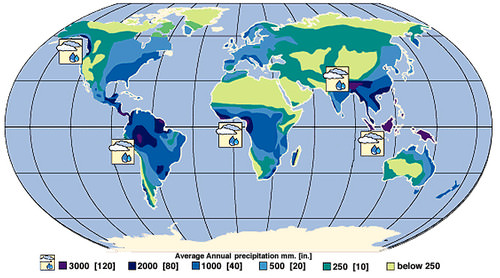
Surface Water Resources: Rivers, Lakes, Glaciers

Flowing water from rain and melted snow on land enters river channels by surface runoff and groundwater seepage (Figure 4 and 5). Rivers are an important water resource for irrigation of cropland and drinking water for many cities around the world. Rivers that have had international disputes over water supply include the Colorado (Mexico, southwest U.S.), Nile (Egypt, Ethiopia, Sudan), Euphrates (Iraq, Syria, Turkey), Ganges (Bangladesh, India), and Jordan (Israel, Jordan, Syria).
River discharge describes the volume of water moving through a river channel over time (connect this idea to watersheds, discussed next). The relative contributions of surface runoff vs. groundwater seepage to river discharge depend on precipitation patterns, vegetation, topography, land use, and soil characteristics. Soon after a heavy rainstorm, river discharge increases due to surface runoff. The steady normal flow of river water is mainly from groundwater that discharges into the river. Gravity pulls river water downhill toward the ocean. Along the way the moving water of a river can erode soil particles and dissolve minerals. Groundwater also contributes a large amount of the dissolved minerals in river water.
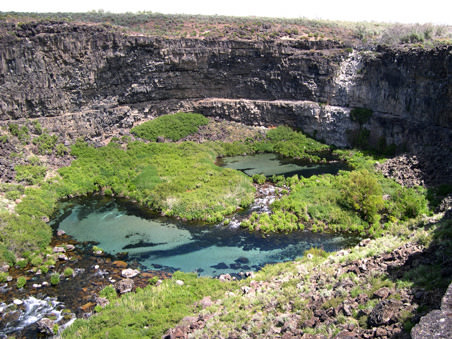
In addition to rivers, lakes can also be an excellent source of freshwater for human use. They usually receive water from surface runoff and groundwater discharge. They tend to be short-lived on a geological time-scale because they are constantly filling in with sediment supplied by rivers.
Lakes form in a variety of ways including glaciation, recent tectonic uplift (e.g., Lake Tanganyika, Africa), and volcanic eruptions (e.g., Crater Lake, Oregon). People also create artificial lakes (reservoirs) by damming rivers. Large changes in climate can result in major changes in a lake’s size. As Earth was coming out of the last Ice Age about 15,000 years ago, the climate in the western U.S. changed from cool and moist to warm and arid, which caused more than 100 large lakes to disappear. The Great Salt Lake in Utah is a remnant of a much larger lake which had been called Lake Bonneville.
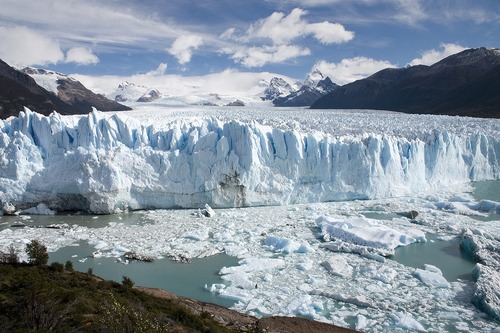
Although glaciers represent the largest reservoir of fresh water, they generally are not used as a water source because they are located too far from most people (Figure 6). However, melt water from glaciers does provide a natural source of river water and groundwater, which can be a very important supply in local water cycles. During the last Ice Age there was as much as 50% more water in glaciers than there is today, which caused sea level to be about 100 m lower. Over the past century, sea level has been rising in part due to melting glaciers. If Earth’s climate continues to warm, the melting glaciers will cause an additional rise in sea level.
Groundwater Resources
The final source of freshwater is groundwater (Figure 7). Groundwater is a much larger reservoir of usable fresh water compared to surface waters, containing more than 30 times more water than rivers and lakes combined. Groundwater is a particularly important resource in arid climates, where surface water may be scarce. Groundwater is defined as the water located in small spaces, called pore space (Figure 8), between mineral grains and fractures in subsurface earth materials (rock or sediment). Groundwater is divided into basins, called aquifers, that can act as independent waterbodies. Often, aquifers are made of porous rock that holds water, which can be drilled to provide water for agriculture and personal use (accessed via wells).
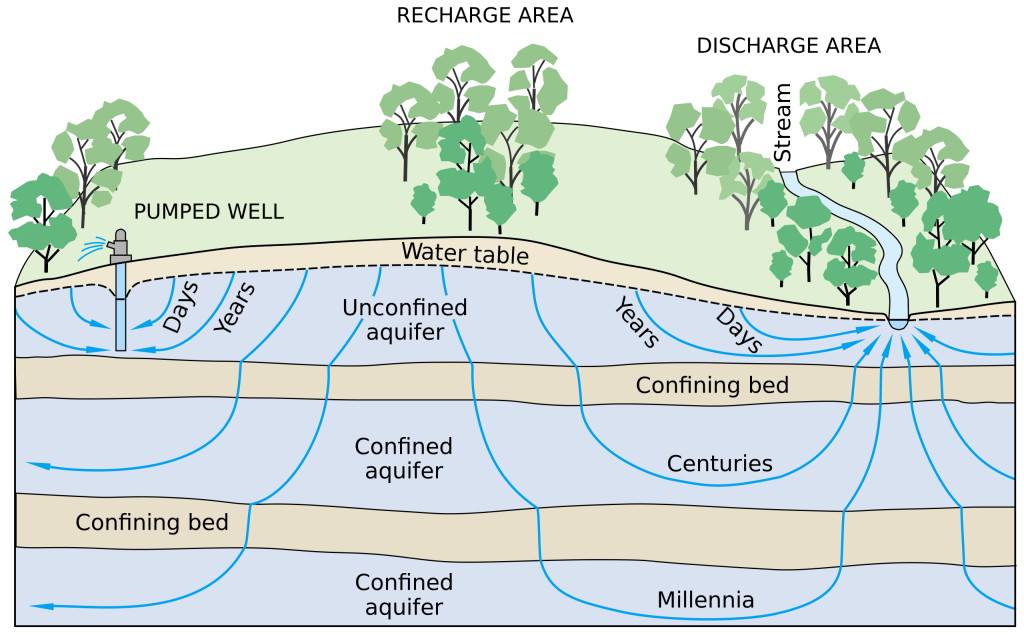
Most groundwater originates from rain or snowmelt, which infiltrates the ground and moves downward until it reaches the saturated zone (where groundwater completely fills pore spaces in earth materials). Other sources of groundwater include seepage from surface water (lakes, rivers, reservoirs, and swamps), surface water deliberately pumped into the ground, irrigation, and underground wastewater treatment systems (septic tanks). Recharge areas are locations where surface water infiltrates the ground rather than running into rivers or evaporating. Wetlands, for example, are excellent recharge areas.
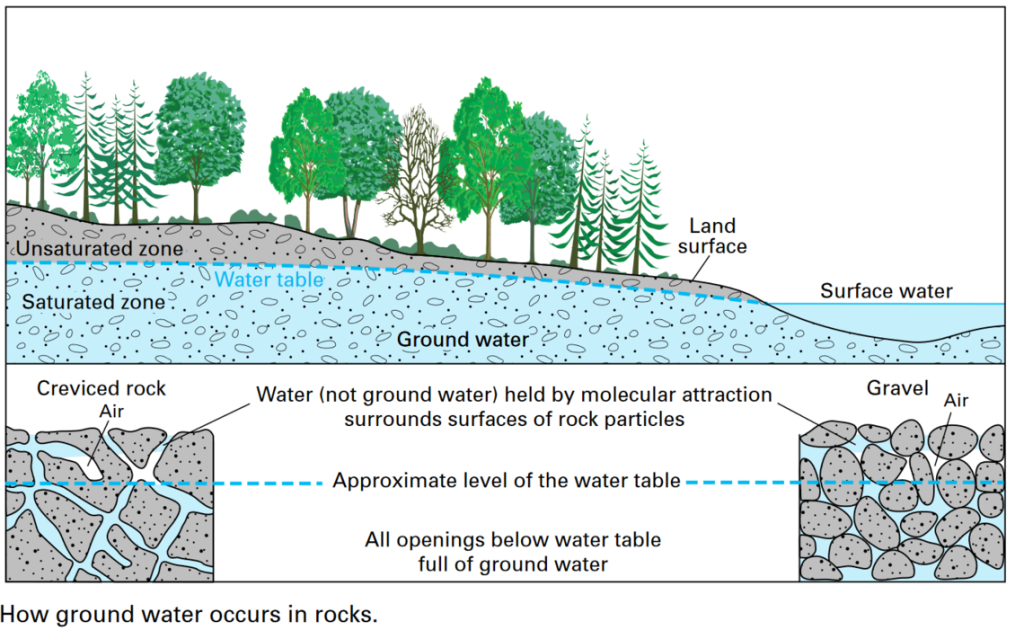
Understanding Water Movement: Watersheds and the Water Table
Watersheds
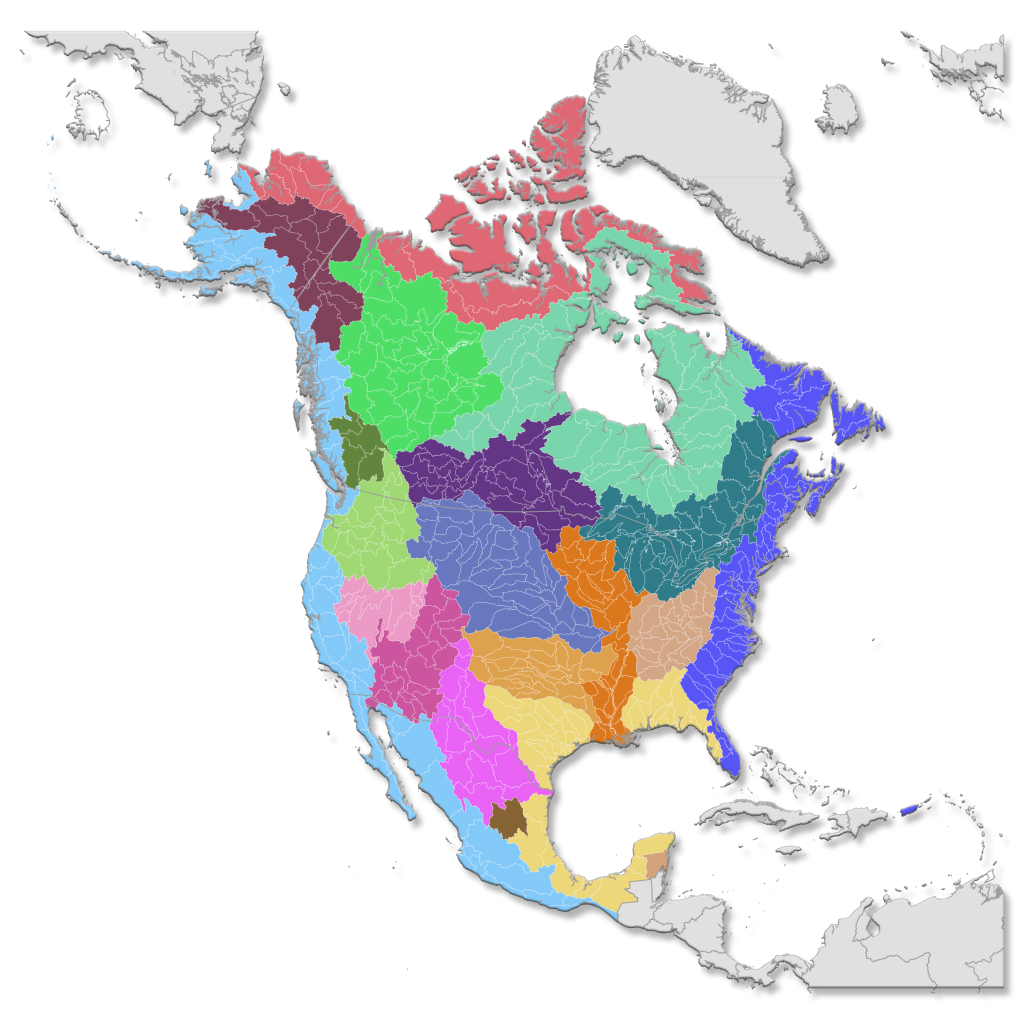
The geographic area drained by a river and its tributaries is called a drainage basin or watershed (Figure 9). Imagine standing on the peak of a ridge; rain falling at that point could drain to either side of the high point. If the two sides of the high point end up in different bodies of water, that peak would be the boundary between the two watersheds. Essentially, a watershed is an area of land that drains all the streams and rainfall to a common outlet such as the outflow of a reservoir, mouth of a bay, or any point along a stream channel. Watersheds can be as small as a footprint or large enough to encompass all the land that drains water into rivers that drain into Chesapeake Bay, where it enters the Atlantic Ocean. For instance, the Mississippi River drainage basin includes approximately 40% of the U.S., and this large watershed is made of smaller drainage basins that can be analyzed as their own watershed. Both the Ohio River and Missouri River help to comprise the Mississippi watershed, and have their own boundaried watershed within that larger watershed. The most obvious usefulness of a watershed (to the average person) is that it defines which communities must work together to manage their freshwater resources. But the concept of a watershed, with a definitive land boundary that drains to a single point, is an enormously useful concept in ecology and environmental science; it allows scientists and agriculturalists to calculated and measure ecosystem processes which relate to the survival of our society and to managing food production.
The Water Table
The final piece of water movement that must be understood is the water table (Figure 10). The water table is the upper surface of the zone of saturation; the zone of saturation is where the pores and fractures of the ground are saturated with water. It can also be simply explained as the depth below which the ground is saturated. When precipitation enters the soil, free-flowing water will be pulled down by gravity until it reaches the water table (which may take a few days). Within an aquifer, the water table is rarely horizontal, but does reflect the surface relief. Where streams, rivers, lakes, and other surface waters are exposed, the surface of the water is essentially an extension of the water table.
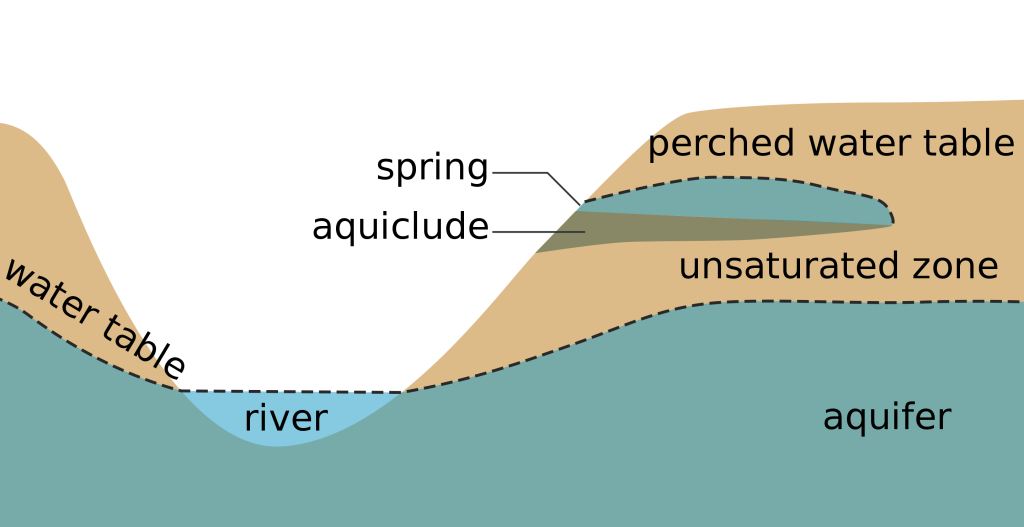
Attribution
Essentials of Environmental Science by Kamala Doršner is licensed under CC BY 4.0. Modified from the original by Matthew R. Fisher and Joni Baumgarten.
Water table by Wikipedia is licensed CCA-SA 3.0. Accessed February 19, 2023. Modified by Joni Baumgarten.
Watersheds and Drainage Basins by USGS; Public Domain. Modified by Joni Baumgarten.

